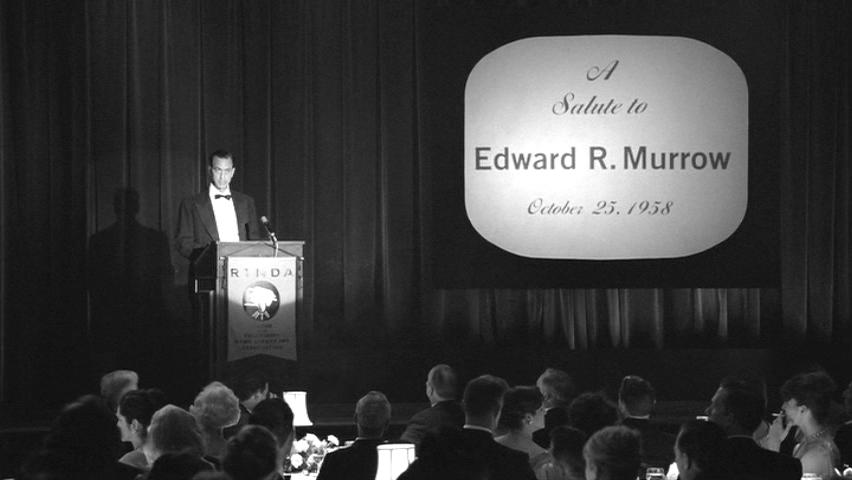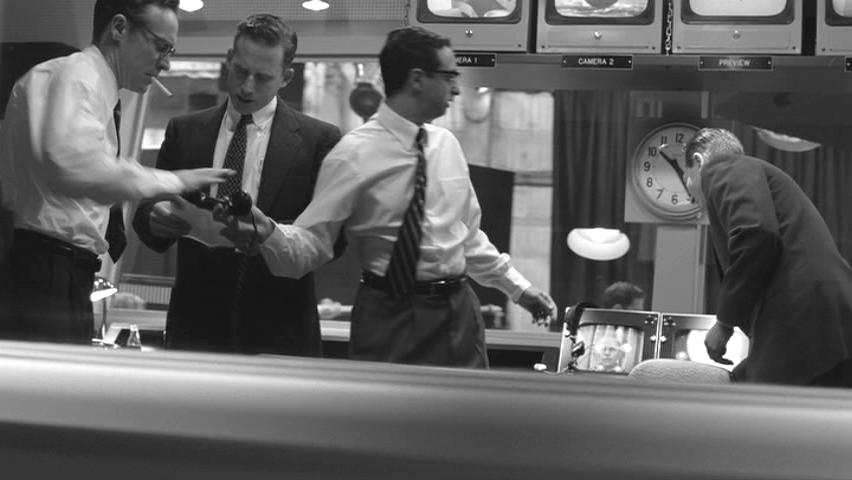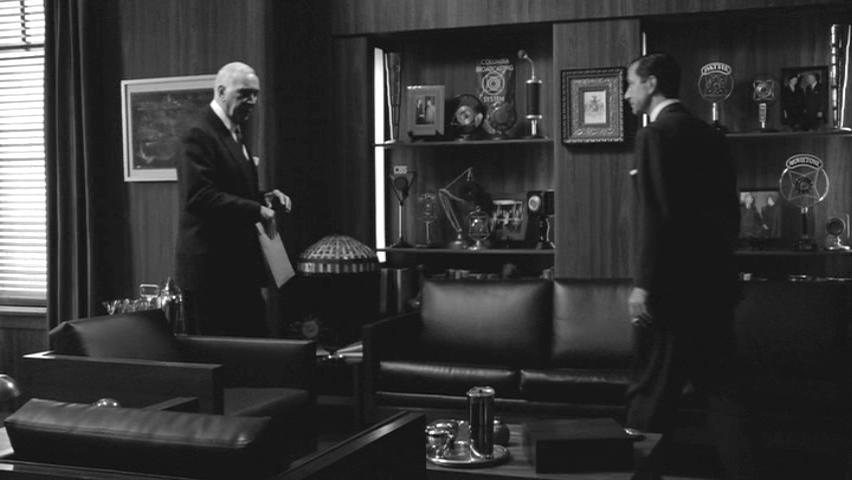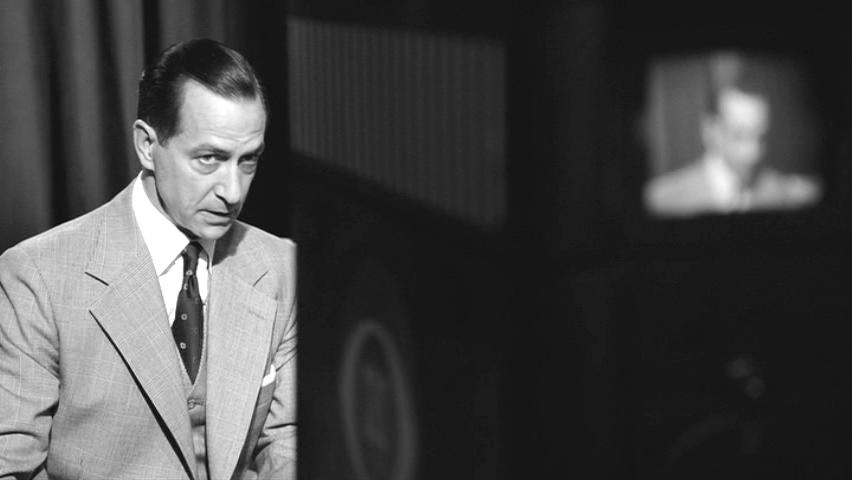This quasi-documentary tells the story of television commentator Edward R. Murrow’s attack on Senator Joseph McCarthy, McCarthy’s counterattack, Murrow’s successful defense, McCarthy’s downfall, and the subsequent downsizing of the CBS news operation. What gives it its intense authenticity is its mix of recently filmed scenes with actual newsreels and kinescopes from the early 1950s.
It is hard to imagine the paranoia of those times if you did not live through them. The U.S. with its allies, including Soviet Russia, had in 1945 defeated the Nazis and their allies. By 1950, the Soviets under Stalin had established their domination over Eastern Europe and had developed their own atomic bomb. Prominent Soviet spies (Hiss, Fuchs) had been discovered in the U.S. and Britain. China had fallen to the Maoists, and the Korean War was about to begin, A lot of conservative opinion held that communism, not Nazism, was America’s proper enemy. We should not have stopped with Germany; we should have fought eastward and knocked off the Russians who were the real threat. And real threat they really seemed, when, after World War II, they emerged as the only other superpower, one seemingly bent upon destroying its capitalist rival, and one with the capability and will to do it. It was then that McCarthy made his key speech.
Joseph McCarthy had gotten himself elected senator from Wisconsin on the basis of a pumped-up war image of “Tail-Gunner Joe,” war hero. In a famous speech in February 1950, he proceeded to capitalize on the fear of Russia and communism by announcing that he, Joe McCarthy, brave and tenacious foe of communism, had discovered hidden communist agents in the State Department, in the Voice of America, in the Army, and on and on. He cleverly used the fledgling medium of television by standing in front of the cameras and brandishing lists of supposed “subversives.” (The number kept varying and ultimately, none ever materialized.) Democrats cowered lest they be the next attacked. Republicans were pleased because the liberalism of the long Roosevelt era was being suppressed. Eisenhower did not respond even when his loyal Secretary of State George Marshall was attacked. A pusillanimous Congress responded by passing laws outlawing various “subversive” organizations including the Communist Party itself. (The saying at the time was that, in the Communist Party, the aging lefties were outnumbered by the FBI spies.)
Most reviewers talked about this film in terms of the history of those days, cataloguing its accuracies and inaccuracies. Fair enough. The film is a quasi-documentary of the ending of a shameful episode in our history. It gains its authenticity by combining film of newly-created scenes with actual footage of the time. from newsreels and kinescopes (movie recordings of television programs). But McCarthyism is all over and done with (although some, like Ann Coulter and William F. Buckley, have tried try to rehabilitate the man and the movement). What can you and I see in this film that is not limited to a particular historical episode, that might be of interest to someone who had never heard of and did not care about Joe McCarthy or Edward R. Murrow?
One thing you cannot miss in this film is smoking. You scarcely ever see Murrow without a cigarette in his hand. Murrow—played to the life by David Strathairn who manages to look almost exactly like him—Murrow himself smokes on screen. That’s part of his image as cool, candid, thoughtful commentator. Other characters shake cigarettes out of packs, light up, offer one another cigarettes, borrow cigarettes, stub cigarettes out—Murrow even has Kent cigarettes for a sponsor (with a doctor promoting them!) Those were the days! Murrow himself died of lung cancer which, tragically, metastasized to the brain of this highly intelligent man. Smoking so pervades this movie that you have to wonder—I have to wonder, anyway—why? Why did director Clooney make such a point of smoking?
Let me suggest a theme: what we knew then and what we know now. In the 1950s I was, like most of my friends, puffing away, and it was only decades later that the evidence became so clear to us that we all had to quit.
In the same way, this movie sets itself firmly in 1950-1954. It uses some lovely 1950s jazz by Dianne Reeves. Although everyone on the news team contributes to the program, the women are treated as merely secretaries. That would not happen now—I hope. Several scenes show us a married couple, Joe Wershba (Robert Downey, Jr. ) and Shirley Wershba (Patricia Clarkson). They have to hide the fact that they’re married from CBS, taking off their wedding rings before they go to work. CBS had an anti-nepotism rule that ultimately forced one of them to resign. This kind of rule has now gone out of fashion. And, of course, the movie is in black and white. (Necessarily. It had to be consistent with its period footage. In fact, Clooney shot the film in color, but on a gray set, and he then had it transferred to black-and-white stock.)
Time— Bookending the McCarthy-Murrow story is a flashforward to a famous 1958 speech by Murrow to a very self-satisfied Radio and Television News Directors Association. He warned them about wasting television’s power to inform and educate the public. We see his old team come together for a reunion photograph. (Again, then and now: we who have seen the media's wretched performance in hyping the Iraq war or the horse-race reporting of presidential elections know that Murrow’s warning went unheeded. I even heard a story on the 2008 candidates’ dogs!)
Then and now. The very title of Murrow’s show, “See It Now,” builds this theme of time, as does the title of the movie (the phrase with which Murrow ended his broadcasts). The first words of the film are, “In 1935 . . . “ The last words are Dianne Reeves’ singing, “One for my baby and one more for the road,” the lovely 3 a.m. song first performed by Fred Astaire. Scarcely a scene goes by in this film without people timing film, complaining about a deadline, or just saying they’re in a hurry. Throughout we get the hurly-burly of early television and live shows. George Clooney plays Fred Friendly, Murrow’s producer and floor manager. We see him crouched at Murrow’s feet during the broadcasts, giving him his 5-4-3-2-1 cues. I’ve always found it interesting that there is no law or regulation requiring that U.S. on-air programming follow the hour and half-hour schedule. It just started, and the networks continued. But it is much in evidence in this picture.
Clooney heightened the time effect by showing us two kinds of space. First there is the claustrophobic newsroom. Clooney heightened the sense of crowdedness and urgency and hubbub by using long lenses to focus on just the busy faces, giving images with little depth of field. That is, they compress the apparent distance to the background, giving you the feeling of a small space, crowded, busy, noisy—a “bunker” Clooney calls it in the DVD commentary.
The contrast comes when we go to the hushed, ordered executive office of William Paley (Frank Langella), head of CBS, Murrow’s boss, and the man who moved advertisers into the dominant force in programming. We enter through an empty, silent corridor colonnaded almost like fascist architecture. Paley’s office is dark, silent, and spacious. The design team (James D. Bissell, Christa Munro, and Jan Pascale) made it twice as big as it actually had been. It is like a funeral home. At the end of the movie, Paley tells Murrow and Friendly, “People want to enjoy themselves.” He banishes See It Now to the wasteland of Sunday afternoon.
Clooney increased the claustrophobic effect in the harshly-lit studio by having only two scenes outside the CBS building. One occurs in a bar where the team awaits the newspaper coverage of their attack on McCarthy. Time dominates the scene again as they wait for the first newspaper coverage. The other scene shows the Wershbas in bed. He wonders, What if we’re wrong? (Again, the idea of then and now. They weren’t wrong.)
Time is one theme I see in this move. Another, obviously enough, is television (or, more generally, the image-making media, for this movie also looks at itself). Television really becomes a character in this movie, motivating people and causing events. It comes in two forms. It is a business and it is an image.
Television is a business, and Paley points out that “The 64 Dollar question brings in $80,000 in sponsors and costs one-third of what you do.” Profit is what makes Paley/CBS use Murrow for the incredibly fake “home visits” of “Person to Person.” In this relentlessly serious movie, one light moment comes when Murrow has to interview Liberace ("Lee") and hear this patently gay man talk about marrying Princess Margaret. Profit is what leads CBS to show Murrow’s interview with Gina Lollobrigida instead of the Army-McCarthy hearings. (And these hearings were what ultimately defeated McCarthy, when the wily old lawyer Joseph Welch looked at him, on national tv, and said, “Have you no sense of decency, sir? At long last, have you left no sense of decency?” Somehow, at that moment, the media, the public, and ultimately the Congress began to turn against the previously invulnerable McCarthy.)
Finally, thinking of television as a business, you could regard this film with a certain irony. It makes one more in a long series of efforts by movie people to run down tv, the thing that has since the 1950s, the time of this film, cut so drastically into the movie industry’s profits.
More importantly, though, and more ironically, television appears as an image. We constantly see the tv monitors in the studio and the CBS building. People in the studio watch Murrow on the monitors; he is simultaneously the person and the image. So is McCarthy. Murrow/Strathairn is dapper, calm, serious, smoking, wise. He exists as an image, and the image is a true one. In one scene, we switch from Straithairn’s face to Murrow’s on a monitor and I, at least, could not tell the difference, a tribute to Straithairn’s acting ability and to make-up.
Are images true or false? Many are surely false. We are treated to a commercial for Kent cigarettes, complete with fake doctor pushing them, telling lies to the American people. We are treated to another commercial for Alcoa aluminum, the usual blather of public relations. McCarthy never worked with facts only reputation—“image.” In this film, he exists only in images, but he was for a time all too real. Now he himself exists only as images in old kinescopes. Murrow too exists now as image, yet his image speaks truth, and he exists now, in this film, as the “real” presence of David Straithairn. The film plays with images. Are they real? Are they true? What is reality? What is truth?
The final shot of a monitor before the banquet closing shows Eisenhower making one of his guarded statements against McCarthy, and Eisenhower’s role in all this was at best ambiguous, at worst gutless. He privately deplored McCarthy’s red-baiting, but publicly hesitated to come out against him. One doesn’t attack fellow-Republicans? Cowardice? A wise decision? Who knows. What was true? What does this image mean?
In short, the film’s playing with images seems to me to become ironical to the point of mystery. If we think about the film’s images in terms of time, the irony becomes even deeper. What is permanent? Which endures, the person or the image? Clearly, in this film, with its sharp emphasis on the passing of time, it is the image. The players in the Murrow-McCarthy drama are now all dead. Real enough then, they exist now only as images in old newsreels or in the made-up scenes of this film. What is true then? What is fact? This is a film about journalism and journalistic integrity and journalism as a business, but those questions remain unanswered and perhaps, from a postmodern perspective, can never be answered. Murrow’s simple faith in “truth” few intellectuals today would share. And that is perhaps the greatest difference between then and now, one that this film leaves as a task for us. It is up to us to decipher truth and falsehood.
I think this is a superb motion picture. It was nominated for six Oscars, one of them for Best Picture, and it won a slew of other awards. The acting is finely understated, and Robert Elswit’s camera work extraordinarily successful. The editing (by Stephen Mirrione) is razor-sharp. But what I most admire is Clooney’s willingness to raise these ultimate questions ironically and to leave the answering, as it must be left, up to us.







